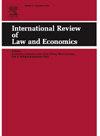Clearance rates and disposition times: Not the whole story of judicial efficiency
IF 1
3区 社会学
Q3 ECONOMICS
引用次数: 0
Abstract
Judicial efficiency is often measured through clearance rate (CR) and disposition time (DT), yet these traditional metrics fail to capture the complexity of resource utilisation in courts. This study critiques the widespread reliance on CR and DT, arguing that they provide an incomplete and potentially misleading picture of judicial efficiency. Using Data Envelopment Analysis (DEA), a non-parametric method designed to measure resource-based efficiency, this research analyses courts across Europe’s three-tier judicial hierarchy. The findings reveal significant shortcomings in CR and DT, including weak or negative correlations with DEA efficiency scores, particularly at the Supreme Court level, where these metrics neglect the intricacies of resource management and case complexity. DEA, by accounting for multiple inputs (e.g., judges, staff, budgets) and outputs (resolved and pending cases), offers a more nuanced framework for measuring efficiency. The analysis highlights inefficiencies hidden behind high CRs and low DTs, suggesting that resource misallocation is a key issue. Furthermore, prioritising efficiency improvements in first-instance courts, where resource bottlenecks are most acute, could generate cascading benefits throughout the judiciary. This study provides empirical evidence for the inadequacy of traditional metrics and advocates for a paradigm shift towards comprehensive tools like DEA to measure judicial efficiency. By moving beyond simplistic case throughput measures, policymakers can design targeted reforms that ensure both the equitable delivery of justice and the sustainable management of judicial resources. The results underscore the urgency of rethinking how justice is measured and understood in modern judicial systems.
清案率和处置时间:并不是司法效率的全部
司法效率通常通过清除率(CR)和处置时间(DT)来衡量,但这些传统指标未能反映法院资源利用的复杂性。本研究批评了对CR和DT的广泛依赖,认为它们提供了一幅不完整的、可能具有误导性的司法效率图景。本研究使用数据包络分析(DEA)——一种旨在衡量基于资源的效率的非参数方法,分析了欧洲三层司法体系的法院。研究结果揭示了CR和DT的重大缺陷,包括与DEA效率得分的弱相关性或负相关性,特别是在最高法院一级,这些指标忽视了资源管理和案件复杂性的复杂性。DEA通过考虑多种投入(例如法官、工作人员、预算)和产出(已解决和未决案件),为衡量效率提供了更细致的框架。该分析突出了高cr和低dt背后隐藏的低效率,表明资源错配是一个关键问题。此外,在资源瓶颈最严重的一审法院优先提高效率,可以在整个司法系统中产生连锁效应。本研究为传统指标的不足提供了经验证据,并倡导向DEA等综合工具的范式转变来衡量司法效率。通过超越简单的案件吞吐量衡量标准,政策制定者可以设计有针对性的改革,确保公平司法和司法资源的可持续管理。调查结果突出表明,迫切需要重新思考在现代司法系统中如何衡量和理解正义。
本文章由计算机程序翻译,如有差异,请以英文原文为准。
求助全文
约1分钟内获得全文
求助全文
来源期刊
CiteScore
2.60
自引率
18.20%
发文量
38
审稿时长
48 days
期刊介绍:
The International Review of Law and Economics provides a forum for interdisciplinary research at the interface of law and economics. IRLE is international in scope and audience and particularly welcomes both theoretical and empirical papers on comparative law and economics, globalization and legal harmonization, and the endogenous emergence of legal institutions, in addition to more traditional legal topics.

 求助内容:
求助内容: 应助结果提醒方式:
应助结果提醒方式:


